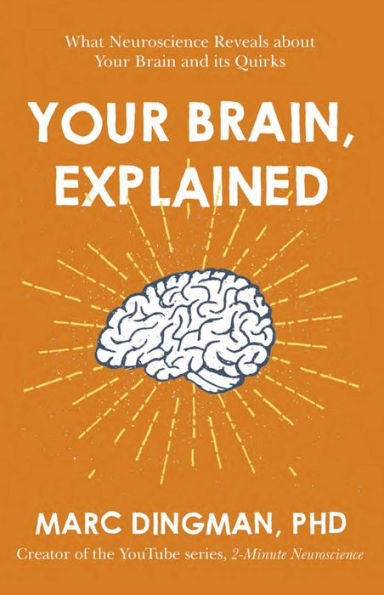
Your Brain, Explained: What Neuroscience Reveals About Your Brain and its Quirks
256
Your Brain, Explained: What Neuroscience Reveals About Your Brain and its Quirks
256Paperback
-
PICK UP IN STORECheck Availability at Nearby Stores
Available within 2 business hours
Related collections and offers
Overview
Your Brain, Explained is a personal tour around your gray matter. Neuroscientist Marc Dingman gives you a crash course in how your brain works and explains the latest research on the brain functions that affect you on a daily basis.
You'll also discover what happens when the brain doesn't work the way it should, causing problems such as insomnia, ADHD, depression, or addiction. You'll learn how neuroscience is working to fix these problems, and how you can build up your defenses against the most common faults of the mind.
Along the way you'll find out:
· Why brain training games don't prevent dementia
· What it's like to remember every day of your life as if it were yesterday
· Which popular psychiatric drug was created from German rocket fuel
· How you might unknowingly be sabotaging your sleep
Drawing on the author's popular YouTube series, 2-minute Neuroscience, this is a friendly, engaging introduction to the human brain and its quirks from the perspective of a neuroscientist—using real-life examples and the author's own eye-opening illustrations. Your brain is yours to discover!

Product Details
| ISBN-13: | 9781473696563 |
|---|---|
| Publisher: | Mobius |
| Publication date: | 05/10/2022 |
| Pages: | 256 |
| Sales rank: | 408,832 |
| Product dimensions: | 5.00(w) x 7.75(h) x 1.00(d) |
About the Author
Table of Contents
Introduction 1
1 Fear 7
The almond of the brain 9
Monkeys, mescaline, and the amygdala 10
Learning about fear 12
The amygdala as a threat detector 13
Afraid before you know it 14
The "fear center" 18
Beyond fear 19
A new view of fear 21
Fear gone wrong 21
2 Memory 27
Memory basics 28
Forming connections, making memories 31
Memory and … sea slugs? 33
Seahorses on the brain 36
The life of a memory 39
Where are memories stored? 41
The rest of the story 41
Alzheimer's disease 42
A grim prognosis 43
Neurodegeneration and Alzheimer's disease 45
Plaques, tangles, and dying neurons 46
3 Sleep 49
Why do we sleep? 51
The origins of sleep science 52
Measuring sleep with the EEG 55
Night moves 57
The sleeping brain 59
Getting more specific 60
Narcolepsy and the sleep control center 62
The sleep switch 64
You're getting sleepy 65
Adenosine and sleep 66
24/7 67
America's favorite drug 68
Caffeine's lingering effects 69
4 Language 73
Broca meets "Tan" 76
Wernicke gets an area of his own 78
Dueling hemispheres 79
The often overlooked role of the right hemisphere 82
The classic model of language 83
A more complicated picture 84
When language is missing 86
Critical periods 88
5 Sadness 91
Broca and the "great limbic lobe" 92
A new lobe 93
Enter the limbic system 95
Moving on from one "system" for emotion 96
Finding sadness in the brain 97
The subgenual cingulate in depression 98
The depression network 101
The serotonin hypothesis 103
Connecting the dots 104
Reuptake and recycling neurotransmitters 105
The belle of the ball 106
Flaws in the serotonin hypothesis 107
Searching for answers 109
6 Movement 112
The search for movement in the brain 114
The motor cortex 117
The motor cortex in action 119
Fine-tuning movement 120
The "little brain" 121
The basal ganglia 124
Parkinson's disease 126
Moving in slow motion 126
A deficiency of dopamine 128
L-DOPA for Parkinson's: a miracle drug? 130
7 Vision 134
The eyes have it 136
An amazing layer of cells 137
Color blindness: myths and truth 139
The diverse landscape of the retina 140
Leaving the eye 142
Vision in the cortex 143
The amazing specificity of visual perception 146
Vision is an imperfect reconstruction 147
Blindness 149
A very particular set of skills 151
Denying the obvious 152
8 Pleasure 154
Indelible memories 156
The search for the reward system 157
Dopamine and reward 158
The pleasure neurotransmitter 159
New perspectives on dopamine 161
What about the pleasure? 164
Addiction 165
A vicious cycle 166
A new view of addiction 171
9 Pain 174
The path of pain-from receptors to the brain 176
A hub for touch and pain 177
Rubbing the pain away 179
Higher mechanisms 181
An important discovery 183
Natural pain relievers 184
The problem of chronic pain 186
Treating pain: a double-edged sword 187
10 Attention 193
Cocktail parties and attention 195
Attention in the brain 197
The limited resource of attention 200
Multitasking 201
Supertaskers 204
Attention-deficit/hyperactivity disorder 205
The ADHD brain 207
ADHD, dopamine, and the rest of the story 208
Afterword 211
Endnotes 213
About the Author 229
Index 231
